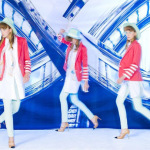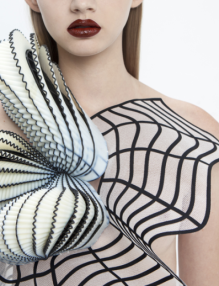Two years ago I have been writing about 3D printing and about that it will revolutionize world’s fashion market. In 2014 this subject was less popular on my blog than Internet of Things in fashion, but still it is important for the global fashion industry so I have decided to check whether I was right in 2012.
What have I been writing in 2012 – 3D printing basics?
In 2012 I have been writing about 3D printing, about that it may revolutionize fashion and that every designer should explore such production process. 3D printing allows rapid prototyping and rapid manufacturing, but this technology wasn’t developed back then nor is it now. Yet a lot of things has changed in that matter. As far back as in 2012 the 3D printers were able to print shoes or accessories. 3D gives you the possibility to transform Haute Couture into Haute Renders.
The status of 3D printing in the fashion industry in 2014.
It has almost been 2 years since I have posted about 3D printing in fashion. A lot has changed. During that time new applications of this technology have appeared. Using this technology to print cosmetics is an interesting example. Mink (New York startup) debuted at TechCrunch Disrupt in May 2014. Grace Choi, a Harvard graduate, is the startup’s founder. The idea is that the customers are able to print cosmetics in desired colors. The project came into being because the founder claims that shops are offering a limited range of colors, plus the prices are too high. Grace Choi wants to offer women easy access to desired colors plus relatively cheap product.
Printed fabrics and dresses.
With architectural knowledge, Bradley Rothenberg has developed a material called “cellular textiles”. This material has its potential in its flexibility, stretch and opacity, and the designer works on such material that would fit to the wearer. This means that he works on the Holy Grail of fashion industry. It is innovative in terms of 3D printing and innovative in fashion. Many doors will open and patents will be worth millions. You could admire a sample of his work on Victoria’s Secret 2013 fashion show.

3D printing material from Bradley Rothenberg
A dress printed for Dita Von Teese was a beautiful and classic example. One can say that it is “a wearable 3D print” example. The dress was created by Francis Bitoni, Michael Schmidt Studios, Shapeways and Sketchfab. Its production costs amounted to $ 100K and was vividly commented on by the media.
Printed shoes – the most common subject in fashion industry.
United Nude (I love this company for their daring shoes projects) has been printing shoes for some time and created a new model: new Coral shoe inspired by corals. They were presented live at the Vogue Fashion Experience. Another pair of shoes, which is available for purchase: Shoes By Bryan – they are interesting because you can adjust them to your taste (different colors as well as models are available).
Vogue prints models.
A cute example, which illustrates the expansion of 3D printing to the world of fashion is Karlie Kloss’s photoshoot. Figurines and photos are beautiful but there is something more about it. Making such photoshoot, Vogue gives the industry a clear signal: 3D is the future of fashion industry.

Karlie Kloss 3d printing NYC Time SQ (source: vogue.com)

Karlie Kloss 3D printing photoshoot – scanning (source: vogue.com)

Previous:
Let’s imagine that the profession of fashion models has gone away

Next:
Internet of things in fashion – wearable technology goes far beyond watches
You may also like
-
 05 Jun
05 JunPhones and fashion – continued. PRADA phone by LG 3.0
Fashion technologyThis is not the news, but those who have not heard – for sure will ...
-
 15 Jun
15 Jun3D printed fashion – use cases from 2013 to 2018
Fashion technology3d printing has been in fashion for a while now and it became interesting between ...
-
 17 Jul
17 JulTED Global 2011 talk which PWNs all
Fashion technologyHere’s Rebecca’s MacKinnon TED Global talk: Let’s take back the Internet! It made a big ...
-
 10 Jul
10 JulSmartphone commercial ads which PWN all!
Fashion technologyHowdy, I spent this afternoon on watching inspiring commercial ads. There were many worth sharing, ...

